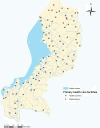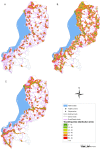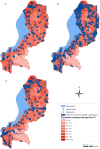Geographical accessibility and spatial coverage modeling of the primary health care network in the Western Province of Rwanda
- PMID: 22984920
- PMCID: PMC3517388
- DOI: 10.1186/1476-072X-11-40
Geographical accessibility and spatial coverage modeling of the primary health care network in the Western Province of Rwanda
Abstract
Background: Primary health care is essential in improving and maintaining the health of populations. It has the potential to accelerate achievement of the Millennium Development Goals and fulfill the "Health for All" doctrine of the Alma-Ata Declaration. Understanding the performance of the health system from a geographic perspective is important for improved health planning and evidence-based policy development. The aims of this study were to measure geographical accessibility, model spatial coverage of the existing primary health facility network, estimate the number of primary health facilities working under capacity and the population underserved in the Western Province of Rwanda.
Methods: This study uses health facility, population and ancillary data for the Western Province of Rwanda. Three different travel scenarios utilized by the population to attend the nearest primary health facility were defined with a maximum travelling time of 60 minutes: Scenario 1--walking; Scenario 2--walking and cycling; and Scenario 3--walking and public transportation. Considering these scenarios, a raster surface of travel time between primary health facilities and population was developed. To model spatial coverage and estimate the number of primary health facilities working under capacity, the catchment area of each facility was calculated by taking into account population coverage capacity, the population distribution, the terrain topography and the travelling modes through the different land categories.
Results: Scenario 2 (walking and cycling) has the highest degree of geographical accessibility followed by Scenario 3 (walking and public transportation). The lowest level of accessibility can be observed in Scenario 1 (walking). The total population covered differs depending on the type of travel scenario. The existing primary health facility network covers only 26.6% of the population in Scenario 1. In Scenario 2, the use of a bicycle greatly increases the population being served to 58% of inhabitants. When considering Scenario 3, the total population served is 34.3%.
Conclusions: Significant spatial variations in geographical accessibility and spatial coverage were observed across the three travel scenarios. The analysis demonstrates that regardless of which travel scenario is used, the majority of the population in the Western Province does not have access to the existing primary health facility network. Our findings also demonstrate the usefulness of GIS methods to leverage multiple datasets from different sources in a spatial framework to provide support to evidence-based planning and resource allocation decision-making in developing countries.
Figures



Similar articles
-
Geographic accessibility to primary healthcare centers in Mozambique.Int J Equity Health. 2016 Oct 18;15(1):173. doi: 10.1186/s12939-016-0455-0. Int J Equity Health. 2016. PMID: 27756374 Free PMC article.
-
Geographical accessibility and spatial coverage modelling of public health care network in rural and remote India.PLoS One. 2020 Oct 21;15(10):e0239326. doi: 10.1371/journal.pone.0239326. eCollection 2020. PLoS One. 2020. PMID: 33085682 Free PMC article.
-
Travel time to health-care facilities, mode of transportation, and HIV elimination in Malawi: a geospatial modelling analysis.Lancet Glob Health. 2020 Dec;8(12):e1555-e1564. doi: 10.1016/S2214-109X(20)30351-X. Lancet Glob Health. 2020. PMID: 33220218 Free PMC article.
-
The current situation of health equity in underserved areas of Afghanistan.Front Public Health. 2024 Sep 24;12:1370500. doi: 10.3389/fpubh.2024.1370500. eCollection 2024. Front Public Health. 2024. PMID: 39381764 Free PMC article. Review.
-
Strategic Enhancement of Healthcare Services During the Hajj Season in Makkah: A Comprehensive Geographic Information System (GIS) Analysis.Cureus. 2024 Aug 28;16(8):e68030. doi: 10.7759/cureus.68030. eCollection 2024 Aug. Cureus. 2024. PMID: 39347331 Free PMC article. Review.
Cited by
-
Geospatial methodology for determining the regional prevalence of hospital-reported childhood intussusception in patients from India.Sci Rep. 2024 Mar 20;14(1):6664. doi: 10.1038/s41598-024-57187-8. Sci Rep. 2024. PMID: 38509132 Free PMC article.
-
Impacts of seasonal flooding on geographical access to maternal healthcare in the Barotse Floodplain, Zambia.Int J Health Geogr. 2023 Jul 31;22(1):17. doi: 10.1186/s12942-023-00338-3. Int J Health Geogr. 2023. PMID: 37525198 Free PMC article.
-
Travel Time to Health Facilities as a Marker of Geographical Accessibility Across Heterogeneous Land Coverage in Peru.Front Public Health. 2020 Sep 16;8:498. doi: 10.3389/fpubh.2020.00498. eCollection 2020. Front Public Health. 2020. PMID: 33042942 Free PMC article.
-
Malaria and the mobile and migrant population in Cambodia: a population movement framework to inform strategies for malaria control and elimination.Malar J. 2015 Jun 20;14:252. doi: 10.1186/s12936-015-0773-5. Malar J. 2015. PMID: 26088924 Free PMC article.
-
Modelling geographical accessibility to support disaster response and rehabilitation of a healthcare system: an impact analysis of Cyclones Idai and Kenneth in Mozambique.BMJ Open. 2020 Nov 3;10(11):e039138. doi: 10.1136/bmjopen-2020-039138. BMJ Open. 2020. PMID: 33148747 Free PMC article.
References
-
- WHO: Primary health care. report of the international conference on primary health care: 6–12 September 1978; Alma-Ata, USSR. Switzerland: WHO, Geneva; 1978.
-
- Hanson K, Ranson MK, Oliveira-Cruz V, Mills A. Expanding access to priority health interventions: a framework for understanding the constraints to scaling-up. J Int Dev. 2003;15(1):1–14. doi: 10.1002/jid.963. - DOI
MeSH terms
LinkOut - more resources
Full Text Sources
Research Materials

